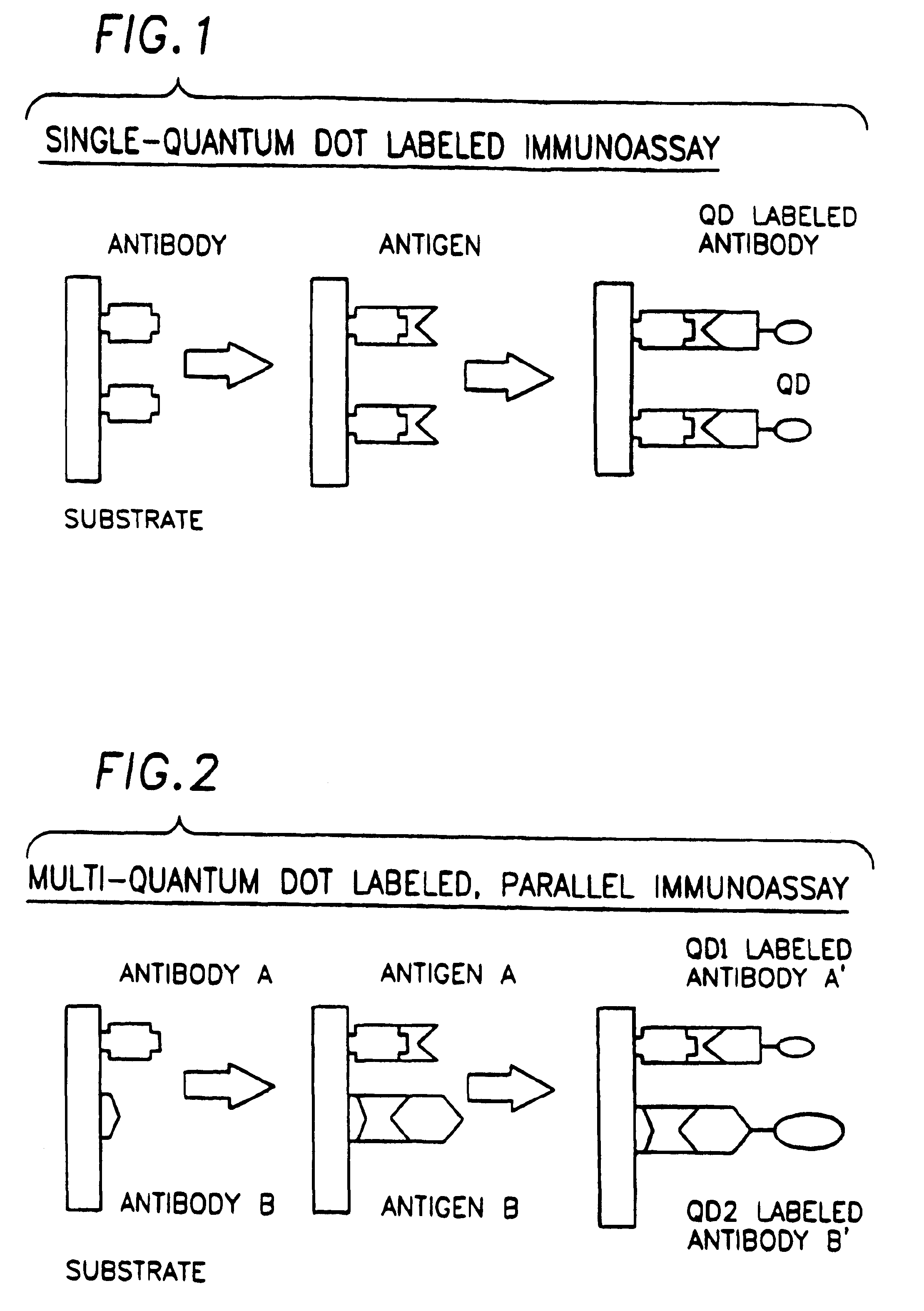Biological applications of quantum dots
- Summary
- Abstract
- Description
- Claims
- Application Information
AI Technical Summary
Benefits of technology
Problems solved by technology
Method used
Image
Examples
example 1
Preparation of TOPO Capped-(CdSe)ZnS
(a) Preparation of CdSe Trioctylphosphine oxide (TOPO, 90% pure) and trioctylphosphine (TOP, 95% pure) were obtained from Strem and Fluka, respectively. Dimethyl cadmium (CdMe2) and diethyl zinc (ZnEt2) were purchased from Alfa and Fluka, respectively, and both materials were filtered separately through a 0.2:m filter in an inert atmosphere box. Trioctylphosphine selenide was prepare by dissolving 0.1 mols of Se shot in 100 ml of TOP thus producing a 1M solution of TOPSe. Hexamethyl(disilathiane) (TMS2S) was used as purchased from Aldrich. HPLC grade n-hexane, methanol, pyridine and n-butanol were purchased from EM Sciences.
The typical preparation of TOP / TOPO capped CdSe nanocrystals follows. TOPO (30 g) was placed in a flask and dried under vacuum (˜1 Torr) at 180° C. for 1 hour. The flask was then filled with nitrogen and heated to 350° C. In an inert atmosphere drybox the following injection solution was prepared: CdMe2 (200 microliters, 2.78 m...
example 2
Preparation of a Water-Soluble Quantum Dots Using Long Chain Mercaptocarboxylic Acid
TOPO capped-(CdSe)ZnS quantum dots were prepared as described in Example 1. The overcoated (CdSe)ZnS dots were precipitated from the growth solution using a mixture of butanol and methanol. To obtain the precipitated quantum dots, the solution was centrifuged for 5-10 min, the supernatant was decanted and the residue was washed with methanol (2×).
The residue was weighed. The weight of the TOPO cap was assumed to be 30% of the total weight; and a 30-fold molar excess of the new capping compound, 11-mercaptoundecanoic acid (MUA) was added. The residue and MUA (neat solution) were stirred at 60° C. for 8-12 hours. A volume of tetrahydrofuran (THF) equal to the added MUA was added to the MUA / dot mixture, with the mixture was still hot. A clear solution resulted and the coated quantum dots were stored under THF.
The coated quantum dots are rendered water-soluble by deprotonation of the carboxylic acid func...
example 3
Associating a Water-Solubilzed Quantum Dot with a Protein
CdSe quantum dots overcoated with ZnS were synthesized, purified, and solubilized in water as previously described. Samples used in this experiment had 40 Å diameter CdSe cores, a ZnS shell which was nominally 4 monolayers (about 9 Å) thick, and capped with 11-mercaptoundecanoic acid (MUA).
The following three reagents were mixed: 5.8 mg of 1-ethyl-3-(3-dimethylaminopropyl) carbodiimide hydrochloride (EDAC), 2.4 mg of N-hydroxysuccinimide (NHS), and 4 mL of a 0.82 micromolar solution of avidin in Millipore filtered water. The initially acidic mixture was treated with 0.1 M NaOH (aq) to adjust the pH to 7.6. Then 3 mL of a 2.1 micromolar aqueous solution of (CdSe)ZnS quantum dots was added. The mixture was stirred for 1 hour at room temperature. Excess reagents were quenched with 1 drop of 0.25 M ethanolamine in water.
To determine whether avidin coupling was successful, the colored reaction solution was passed through a short co...
PUM
| Property | Measurement | Unit |
|---|---|---|
| Quantum yield | aaaaa | aaaaa |
| Size | aaaaa | aaaaa |
| Solubility (mass) | aaaaa | aaaaa |
Abstract
Description
Claims
Application Information
 Login to View More
Login to View More - R&D
- Intellectual Property
- Life Sciences
- Materials
- Tech Scout
- Unparalleled Data Quality
- Higher Quality Content
- 60% Fewer Hallucinations
Browse by: Latest US Patents, China's latest patents, Technical Efficacy Thesaurus, Application Domain, Technology Topic, Popular Technical Reports.
© 2025 PatSnap. All rights reserved.Legal|Privacy policy|Modern Slavery Act Transparency Statement|Sitemap|About US| Contact US: help@patsnap.com



